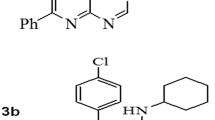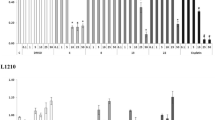Abstract
Allopurinol, a xanthine oxidase inhibitor, impaired the cytotoxic effect of human recombinant tumor necrosis factor (TNF) against WEHI cells. Actinomycin D abolished the inhibition of cytotoxicity by allopurinol. Allopurinol also exerted an inhibitory effect on the production of TNF by human mononuclear cells stimulated by either heat-killed Staphylococcus aureus or E. coli lipopolysaccharide. It is suggested that allopurinol inhibits TNF cytotoxicity by decreasing the level of oxygen free radicals generated (among other mechanisms) by the action of xanthine oxidase. Whatever the mechanism, the fact that allopurinol counteracts the toxicity of TNF can help towards an understanding of the complex nature of TNF toxicity.
Similar content being viewed by others
References
Böyum A (1968) Separation of leukocytes from blood and bone marrow. Scand J Clin Lab Invest 21[Suppl 97]:77–89
Bonavida B (1992) TNF and TNF receptors: structure, mechanism of action and role in disease and therapy. Drugs Today 28:521–525
Cerami A (1992) Inflammatory cytokines. Clin Immun Immunopathol 62:S3-S10
Crowell JW, Jones CE, Smith EE (1969) Effect of allopurinol on hemorrhagic shock. Am J Physiol 216:744–748
Espevik T, Niessen-Meyer J (1986) A highly sensitive cell line, WEHI 164 clone 13, for measuring cytotoxic factor/tumor necrosis factor from human monocytes. J Immunol Methods 95:99–105
Friedl HP, Till GO, Ryan US, Ward PA (1989) Mediator-induced activation of xanthine oxidase in endothelial cells. FASEB J 3:2512–2518
Gelin J, Andersson C, Lundholm K (1991) Effects of indomethacin, cytokines, and cyclosporin A on tumor growth and the subsequent development of cancer cachexia. Cancer Res 51:880–995
Hansson R, Gustafsson B, Jonsson O, Lundstam S, Pettersson S, Scherstén T, Waldenström J (1982) Effect of xanthine oxidase inhibition on renal circulation after ischemia. Transplant Proc 14: 51–58
Larrick JW, Wright SC (1990) Cytotoxic mechanism of tumor necrosis factor-α. FASEB J 4:3215–3223
Lattime EC, Stoppacciaro A, Khan A Stutman O (1988) Human natural cytotoxic activity mediated by tumor necrosis factor: regulation by interleukin-2. J Natl Cancer Inst 80:1035–1038
Liang MH, Fries JF (1978) Asymptomatic hyperuricemia: the case for conservative management. Ann Int Med 88:666–670
Lloyd SS, Chang AK, Taylor FB Jr, Janzen EG, McCay PB (1993) Free radicals and septic shock in primates: the role of tumor necrosis factor. Free Radiol Biol Med 14:233–242
Mándi Y, Endrész V, Krenács L, Régely K, Degré M, Béládi I (1991) Tumor necrosis factor production by human granulocytes. Int Arch Allergy Appl Immunol 96:101–106
Marks JD, Marks CB, Luce JM (1990) Plasma tumor necrosis factor in patients with septic shock: Mortality rate, incidence of adult respiratory distress syndrome. Am Rev Respir Dis 141:94–97
Mintz M, Rapaport R, Oleske JM, Connor EM, Koenigsberger MR, Denny T, Epstein LG (1989) Elevated serum levels of tumor necrosis factor are associated with progressive encephalopathy in children with acquired immunodeficiency syndrome. AJDC 143:771–774
Murphy HS, Shaymann JA, Till GO, Mahrougui M, Owens CB, Ryan US, Ward PA (1992) Superoxide responses of endothelial cells to C5a and TNF-alpha: divergent signal transduction pathways. Am J Physiol 263:51–59
Niehorster M, Schonharting M, Wendel A (1992) A novel xanthine derivative counteracting in vivo tumor necrosis factor alpha toxicity in mice. Circ Shock 37:270–273
Ogata M, Matsumoto T, Koga K, Takenaka I, Kamochi M, Sata T, Yoshida S-I, Shigematsu A (1993) An antagonist of platelet-activating factor suppresses endotoxin -induced tumor necrosis factor and mortality in mice pretreated with carrageenan. Infect Immun 61:699–704
Ohno I, Tanno Y, Yamauchi K, Takishima T (1990) Production of tumor necrosis factor by mastocytoma P815 cells. Immunology 69:312–315
Old LJ (1985) Tumor necrosis factor (TNF). Science 230:630–632
Ortaldo JR, Mason LH, Mathieson BJ, Liang S-M, Flick DA, Herberman RB (1986) Mediation of mouse natural cytotoxic activity by tumor necrosis factor. Nature 321:700–702
Robertson MJ, Ritz J (1990) Biology and clinical relevance of human natural killer cells. Blood 76:2421–2438
Semmler J, Gebert U, Eisenhut T, Moeller J, Schönharting MM, Alléra A, Endres S (1993) Xanthine derivatives: comparison between suppression of tumor necrosis factor-α production and inhibition of cAMP phosphodiesterase activity. Immunology 78:520–525
Spector T (1977) Inhibition of urate production by allopurinol. Biochem Pharmacol 26:355–358
Tiegs G (1989) Tumor necrosis factor is a terminal mediator in galactosamine/endotoxin-induced hepatitis in mice. Biochem Pharmacol 38:627–631
Tracey KJ, Cerami A (1992) Tumor necrosis factor and regulation of metabolism in infection: role of systemic versus tissue levels. Proc Soc Exp Biol Med 200:233–239
Vasko KA, DeWall RA, Riley AM (1972) Effect of allopurinol in renal ischemia. Surgery 71:787–790
Vassalli P (1992) The pathophysiology of tumor necrosis factors. Annu Rev Immunol 10:411–452
Weinberg JB, Mason SN, Wortham TS (1992) Inhibition of tumor necrosisfactor-α (TNF-α) and interleukin-1β (IL-β) messenger RNA (mRNA) expression in HL-60 leukemia cells by pentoxifylline and dexamethasone: dissociation of acivicin-induced TNF-α and IL-β mRNA expression from acivicin-induced monocytoid differentiation. Blood 79:3337–3343
Author information
Authors and Affiliations
Additional information
Correspondence to: Y. Mándi at the above address
Rights and permissions
About this article
Cite this article
Oláh, T., Régely, K. & Mándi, Y. The inhibitory effects of allopurinol on the production and cytotoxicity of tumor necrosis factor. Naunyn-Schmiedeberg's Arch Pharmacol 350, 96–99 (1994). https://doi.org/10.1007/BF00180017
Received:
Accepted:
Issue Date:
DOI: https://doi.org/10.1007/BF00180017




